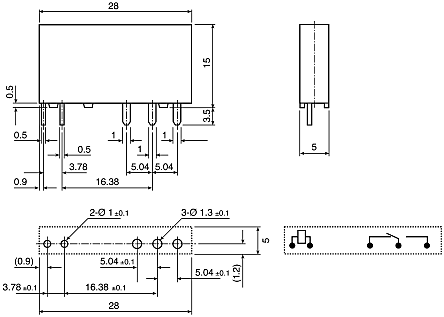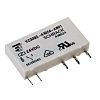RS PRO PCB Mount Non-Latching Relay, 24V dc Coil, 6A Switching Current, SPDT
- RS Stock No.:
- 476-630
- Brand:
- RS PRO
Discontinued product
Alternative
This product is not currently available. Here is our alternative recommendation.
Each
£7.17
(exc. VAT)
£8.60
(inc. VAT)
- RS Stock No.:
- 476-630
- Brand:
- RS PRO
- COO (Country of Origin):
- CN
Slim Relays
Slim size (width 5mm)
High sensitivity, coil power 170mW
4kV dielectric strength (between coil and contacts)
Surge voltage up to 6kV (between coil and contacts)
Wash tight
Clearance/creepage distance 8mm
High sensitivity, coil power 170mW
4kV dielectric strength (between coil and contacts)
Surge voltage up to 6kV (between coil and contacts)
Wash tight
Clearance/creepage distance 8mm
Approvals
UL (File no. E133481), VDE (File no. 40020043)

RS PRO 10 A DPDT Non-Latching Relay
Innovation brings new solutions and makes life more comfortable for us all. An electrical switching device is one of them to appreciate from Automotive engines, industrial machinery to more tangible in household applications, regardless whether it is latching or non-latching Relay. They both represent a different approach to application functionality, bringing your electronics world to life.
Today, we are proudly introducing our own branded RS PRO SPDT Relay giving you environmentally friendly product without compromising high breakdown voltage of 4 kV (between coil and contacts).
Relay rating is showing in ac and dc, and it is crucial never to exceed the maximum switching voltage. Our SPDT (single pole, double throw) Relay provides 400 V ac and 125 V dc telling you about the specific amount of power that can be switched through the Relays.
Our range of Non-Latching Relays are reliable, well-respected electronics, offering you competitive price range without compromising quality and you can be sure to find them in stock. If you are looking for more specific information, you can check our datasheet that should answer your burning questions.
Today, we are proudly introducing our own branded RS PRO SPDT Relay giving you environmentally friendly product without compromising high breakdown voltage of 4 kV (between coil and contacts).
Relay rating is showing in ac and dc, and it is crucial never to exceed the maximum switching voltage. Our SPDT (single pole, double throw) Relay provides 400 V ac and 125 V dc telling you about the specific amount of power that can be switched through the Relays.
Our range of Non-Latching Relays are reliable, well-respected electronics, offering you competitive price range without compromising quality and you can be sure to find them in stock. If you are looking for more specific information, you can check our datasheet that should answer your burning questions.
Features and Benefits
- Very slim size (width 5 mm)
- High sensitivity
- Coil power of 170 mW
- 4 kV dielectric strength (between coil and contacts)
- Surge voltage up to 6 kV (between coil and contacts)
- Wash tight
- Clearance/creepage distance of 8 mm
- RoHS Compliant, meaning this Non-Latching Relay is environmentally friendly
- Outline dimensions are 28.00 x 5.00 x 15.00 mm
Applications
Terminal compact size and reliable mechanism of the Relay Circuit has its place in the following applications:
- Automotive engines
- Household applications
- Industrial machinery
- Medical equipment
- Telecommunications equipment
Frequently asked questions
What is the difference between latching and non-latching relays?
Both types of relays in similar in design and function; however, a significant difference between them is that a latching relay will remain in the last position when it was last powered. In contrast, a non-latching goes back to its normal position. This makes each more type of Relay suitable for different applications.
Does it make much difference which way a Relay is installed?
If the coil polarity is backwards, the coil is ultimately shorted by the diode every single time you try to turn it on. Therefore, Relays must always have the correct position (correct polarity); otherwise, it is a matter of time before smoke will appear, meaning Relays are polarity sensitive.
Both types of relays in similar in design and function; however, a significant difference between them is that a latching relay will remain in the last position when it was last powered. In contrast, a non-latching goes back to its normal position. This makes each more type of Relay suitable for different applications.
Does it make much difference which way a Relay is installed?
If the coil polarity is backwards, the coil is ultimately shorted by the diode every single time you try to turn it on. Therefore, Relays must always have the correct position (correct polarity); otherwise, it is a matter of time before smoke will appear, meaning Relays are polarity sensitive.
Why RS PRO?
RS PRO is our family brand to go-to and brings you a wide range for high-quality and high-value products to support your project. Trusted by engineers all over the world, every part of every RS PRO product is always rigorously tested against demanding industry standards. We are only giving the RS PRO seal of approval if we are confident of their exceptional quality, which means you can be convinced too.
Attribute | Value |
|---|---|
| Coil Voltage | 24V dc |
| Contact Configuration | SPDT |
| Mounting Type | PCB Mount |
| Switching Current | 6A |
| Number of Poles | 1 |
| Terminal Type | Through Hole |
| Maximum Switching Voltage AC | 400V ac |
| Maximum Switching Voltage DC | 125V dc |
| Length | 28mm |
| Coil Resistance | 3.39 kΩ |
| Coil Power | 170mW |
| Standards Met | RoHS Compliant, UL E133481, VDE 40020043 |
| Height | 15mm |
| Isolation Coil To Contact | 4kV ac |
| Maximum Operating Temperature | +85°C |
| Minimum Operating Temperature | -40°C |
| Contact Material | Silver Alloy |
| Life | 10000000 (Mechanical) cycles, 60000 (Electrical) cycles |
| Depth | 5mm |
| Maximum Switching Power DC | 180 W |
| Maximum Switching Power AC | 1.5 kVA |
| Application | Power |


